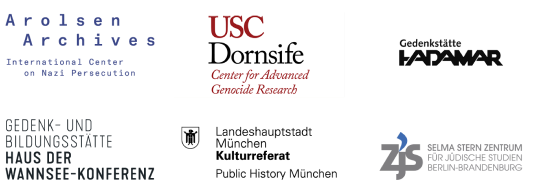Annotations
Bad Homburg
06/10/1942
The photo was taken while 27 people from Bad Homburg and Oberursel persecuted as Jews were being deported and shows about ten people standing with luggage in front of Bad Homburg the city hall, guarded by two police officers. The people on the sidewalk in the background were probably bystanders.
Image: Archives of the YIVO Institute for Jewish Research
Annotations
People
2
Keywords
3
Historical context
Deportation von Bad Homburg nach Majdanek und Sobibor am 11.06.1942
On June 10, 1942, 27 persons from Bad Homburg and Oberursel, persecuted as Jews, were deported from Bad Homburg.This deportation was the last of three deportations organized by the Frankfurt Gestapo in May and June and implemented with the help of district administrators and mayors. The “Reichsvereinigung der Juden” (Reich Association of Jews), which was controlled by the Gestapo, had to inform the people concerned about their impending deportation on June 6 or 7. On June 10, the deportees were first taken to Frankfurt and detained in the Großmarkthalle (a wholesale market hall) in the Ostend suburb together with hundreds of other people from the Wiesbaden administrative district. The next day, the more than 1,200 people had to board a train to Lublin in occupied Poland. Up to 250 of the men aged 15 to 50 were taken from there to the Majdanek concentration and extermination camp. The other people were murdered in the Sobibór extermination camp. None of the people deported on this transport are known to have survived.
About the image series
This is the only known photograph of the deportation of Jews from Bad Homburg vor der Höhe. A digital copy of the photograph is kept at the Leo Baeck Institute New York. In addition, a physical copy of the picture has survived in the archives of the YIVO - Institute for Jewish Research in New York. The back of the physical copy bears a reference to the date of the deportation on June 10, 1942 (see picture 2 of this series). The photograph shows about ten people standing with luggage in front of Bad Homburg city hall in Louisenstraße 59. In addition, two police officers and another uniformed person with a bicycle can be seen. The people on the sidewalk in the background are probably bystanders.
Photographer
Unknown,
Provenance
In addition to the date June 10, 1942, the back of the physical copy of the photograph kept in the archives of the YIVO - Institute for Jewish Research bears a stamp with the name and address of Robert Schlesinger in Bad Homburg (cf. picture 2 of this series). This person is named as a contributor in the database of the Leo Baeck Institute as well. From an application for assistance he filed with the International Refugee Organization in 1949, it is evident that Robert Schlesinger was a Jewish survivor from Breslau who moved to Bad Homburg in 1946. He subsequently founded the Jewish community there. The back likewise bears the note that the YIVO received the copy of the photograph in March 1948 from a person named P. Fursht (or Pursht) from Frankfurt.
Call number at source archive
RG 120 Germany 1933-45 Bad Homburg 1
Title at source archive
Deportation of Jews from Bad Homburg
Acknowledgements
For their assistance with our research, we would like to thank Angelika Rieber, who has published numerous research papers on biographies of Jewish persons from the Rhine-Main region; Peter Maresch, archivist at Kreisarchiv Hochtaunuskreis; Dr. Astrid Krüger, head of Stadtarchiv Bad Homburg, Michael Simonson, archivist and Director of Public Outreach at the Leo Baeck Institute; and Vital Zajka, photo archivist at the YIVO - Institute for Jewish Research.
Text and research by Katharina Menschick.
Kooperationsverbund #LastSeen. Bilder der NS-Deportationen Dr. Alina Bothe Projektleiterin
c/o Selma Stern Zentrum für Jüdische Studien Berlin-Brandenburg
Freie Universität Berlin
Habelschwerdter Allee 34A
14195 Berlin
lastseen@zedat.fu-berlin.de
Ein Kooperationsprojekt von

Gefördert durch

Datenschutz | Impressum